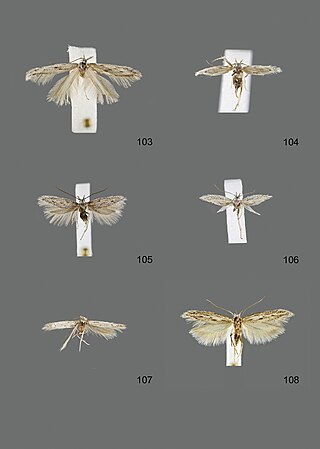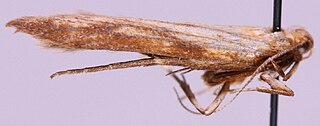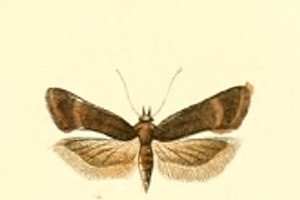
Megacraspedus is a genus of moths in the family Gelechiidae, found primarily in the Palearctic.
Megacraspedus albovenata is a moth of the family Gelechiidae. It is found in the southern Urals, the Czech Republic and Slovakia. The habitat consists of grassy steppe.

Aristotelia subericinella is a moth of the family Gelechiidae. It is found in southern and eastern Europe, The Ural Mountains, Turkey and Central Asia.

Caryocolum kroesmanniella is a moth of the family Gelechiidae. It is found from Fennoscandia to the Pyrenees, Alps and Romania and from Great Britain to southern Russia. The habitat consists of open woodland.
Megacraspedus litovalvellus is a moth of the family Gelechiidae. It is found in Russia. The habitat consists of chalk steppes.

Megacraspedus multispinella is a moth of the family Gelechiidae. It is found in Russia. The habitat consists of rocky steppe slopes with lush low vegetation.
Megacraspedus orenburgensis is a moth of the family Gelechiidae. It is found in Russia. The habitat consists of chalk steppe.
Lutilabria prolata is a moth of the family Gelechiidae. It is found in Russia and Romania. The habitat consists of steppe.
Helcystogramma flavescens is a moth of the family Gelechiidae. It is found in Russia. The habitat consists of grassy steppes.
Megacraspedus separatellus is a moth of the family Gelechiidae. It is found from central and southern Europe to the Ural Mountains. Outside Europe it is found in the Altai Mountains, Turkey and the Caucasus.
Megacraspedus attritellus is a moth of the family Gelechiidae. It is found in Russia and possibly Turkey.
Megacraspedus argyroneurellus is a moth of the family Gelechiidae. It is found in Russia, Ukraine, Central Asia, the northern Caucasus and Turkey.
Megacraspedus lagopellus is a moth of the family Gelechiidae. It is found in Russia and Hungary.
Megacraspedus balneariellus is a moth of the family Gelechiidae. It is very locally distributed from central Europe to the Ural Mountains.
Megacraspedus niphorrhoa is a moth of the family Gelechiidae. It is found in Russia and Kazakhstan (Uralsk).
Megacraspedus fallax is a moth of the family Gelechiidae. It is found in France, Spain, Hungary, southern Ukraine, Russia, the Caucasus and from Kazakhstan to north-western China.

Metzneria neuropterella, the brown-veined neb, is a moth of the family Gelechiidae. It is found from most of Europe to the southern Ural Mountains, the Caucasus, southern and south-eastern Siberia and Mongolia, as well as in North Africa. The habitat consist of short-turfed, herb rich chalk downland.
Metzneria artificella is a moth of the family Gelechiidae. It is found from southern and eastern Europe to the southern Ural and the Volga region. It is also found in Iran and southern Siberia.
Monochroa parvulata is a moth of the family Gelechiidae. It is found from southern and central Europe to Estonia in the north and the southern Ural in the east.

Filatima spurcella is a moth of the family Gelechiidae. It is found from central and southern Europe to the southern Ural and Turkey.





